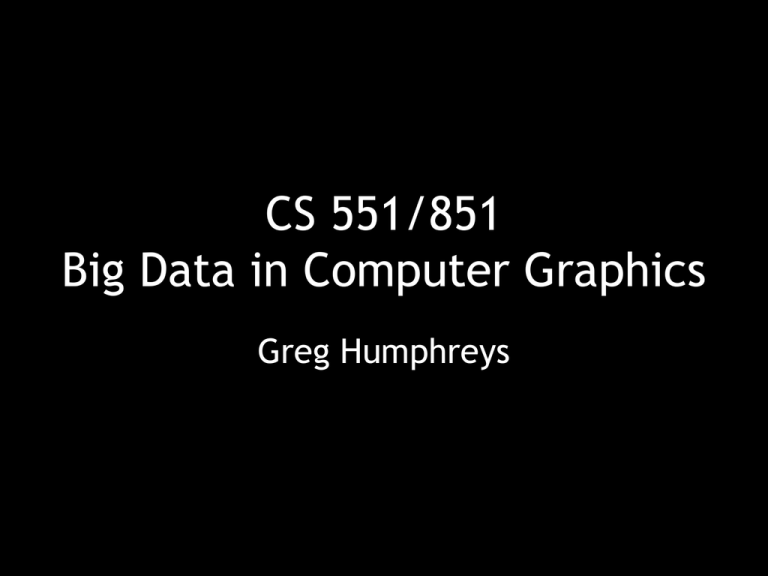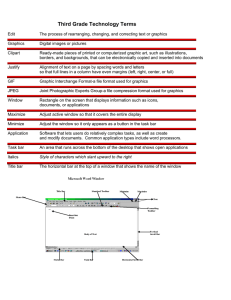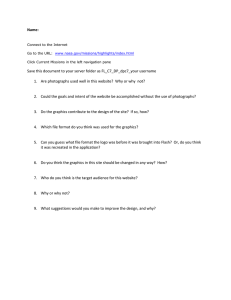CS 551/851 Big Data in Computer Graphics Greg Humphreys
advertisement

CS 551/851 Big Data in Computer Graphics Greg Humphreys What does “big” mean? “I cannot define it, but I know it when I see it” - Justice Potter Stewart • “Big” is a relative term • It happens whenever a resource is fully consumed Big Data in Computer Graphics Fall 2002 Lecture 1 Big Models Pratt-Whitney 6000 turbine engine and rotor blade 120 million cell calculation, 500,000 triangle surface Stanford Center for Integrated Turbulence Simulations Big Data in Computer Graphics Fall 2002 Lecture 1 Big Models Double Eagle Tanker Model: 83 million triangles UNC Walkthrough Project Big Data in Computer Graphics Fall 2002 Lecture 1 Big Models Scans of Saint Matthew (386 MPolys) and the David (2 GPolys) Stanford Digital Michelangelo Project Big Data in Computer Graphics Fall 2002 Lecture 1 Big Displays Window system and large-screen interaction metaphors François Guimbretière, Stanford University HCI group Big Data in Computer Graphics Fall 2002 Lecture 1 Big Displays Simulation of Compressible Turbulence (2K x 2K x 2K mesh) Sean Ahern and Randall Frank, LLNL Big Data in Computer Graphics Fall 2002 Lecture 1 Big LCD Displays 2400 3840 Jet engine nacelle model courtesy Goodrich Aerostructures Peter Kirchner and Jim Klosowski, IBM T.J. Watson Big Data in Computer Graphics Fall 2002 Lecture 1 Big Sloppy Displays WireGL extensions for casually aligned displays UNC PixelFlex team and Michael Brown, UKY Big Data in Computer Graphics Fall 2002 Lecture 1 Big Texture Maps 153K x 153K = 73GB!! Using Texture Mapping with Mipmapping to Render a VLSI Layout Solomon and Horowitz, DAC 2001 Big Data in Computer Graphics Fall 2002 Lecture 1 Big Dynamic Range Big Data in Computer Graphics Fall 2002 Lecture 1 Big Dynamic Range 1/1000 1/500 1/250 1/125 1/60 1/30 1/15 1/8 1/4 Gradient Domain High Dynamic Range Compression Fattal, Lischinski and Werman, SIGGRAPH 2002 Big Data in Computer Graphics Fall 2002 Lecture 1 Big Chips • • • • • • • GeForce4 die plot courtesy NVIDIA Big Data in Computer Graphics Fall 2002 Lecture 1 63 MTransistors 1.23 TOps/sec (!) 10 GB/sec 136 MTris/sec 1.2 GPix/sec 4 rendering pipes 8 textures Big… Everything Realistic Modeling and Rendering of Plant Ecosystems Deussen, Hanrahan, Lintermann, Mech, Pharr and Prusinkiewicz, SIGGRAPH 1998 Big Data in Computer Graphics Fall 2002 Lecture 1 What Once Was Big… 1 mo. 106 s log time Courtesy Frank Crow, Interval Fanatical 1 week 1 day 104 s Possible Teddy Bear 250 GI’s 1 hr. 100 s Practical 1 min. Kitchen Table 10 GI’s Interactive 1.0 s 10 gips 1 gips 100 mips 10 mips Big Data in Computer Graphics Fall 2002 Lecture 1 100 gips Immersive 0.01 s Stemware 100 MI’s log performance Slide courtesy Pat Hanrahan and Kurt Akeley Course Information • • • • • • Seminar-style: Read + discuss Tuesday/Thursday 2:00-3:15 in Olsson 228E Office hours MW 10:00-12:00 in Olsson 216 Discussions will be student-led One assignment, one project Course web page: http://www.cs/~gfx/Courses/2002/BigData • This is an experiment. Feedback is crucial! Big Data in Computer Graphics Fall 2002 Lecture 1 Discussions • Each student will lead at least one class • Prepared presentation for 30-45 minutes: – – – – Background information Paper summaries Key ideas Interruptions encouraged • Guide discussion • All students will submit 2-3 questions about the reading before class, use those as a starting point • Starting 9/10 (I’ll do the first three) Big Data in Computer Graphics Fall 2002 Lecture 1 Assignment 0 • Choose days to present • Submit your first three choices • Due evening of 9/3 Big Data in Computer Graphics Fall 2002 Lecture 1 Assignment: Benchmarking • Probe performance characteristics of graphics hardware • Basics: triangle/fill rates, texture download • Extras – – – – – Triangle areas/shapes Texture cache Vertex cache Interface bottleneck Others? • Due September 26th Big Data in Computer Graphics Fall 2002 Lecture 1 Projects • Two months investigating something cool • Need not be novel, but it helps (especially for you graduate students) • Can work in groups no larger than 2 • Writeup quality important: treat it as a conference submission • Topic proposal due October 3rd • Writeup/presentations due December 3rd • Consider publishing your work… Big Data in Computer Graphics Fall 2002 Lecture 1 About Greg • B.S.E. Princeton, 1997 • Ph.D. Stanford, 2002 • CTO, Ahpah Software (Reverse-engineering technology) • Research focus on scalable rendering using commodity technology: “Chromium” • Writing textbook on Image Synthesis (class next semester) • Looking for students who like serious hacking (hint) Big Data in Computer Graphics Fall 2002 Lecture 1




